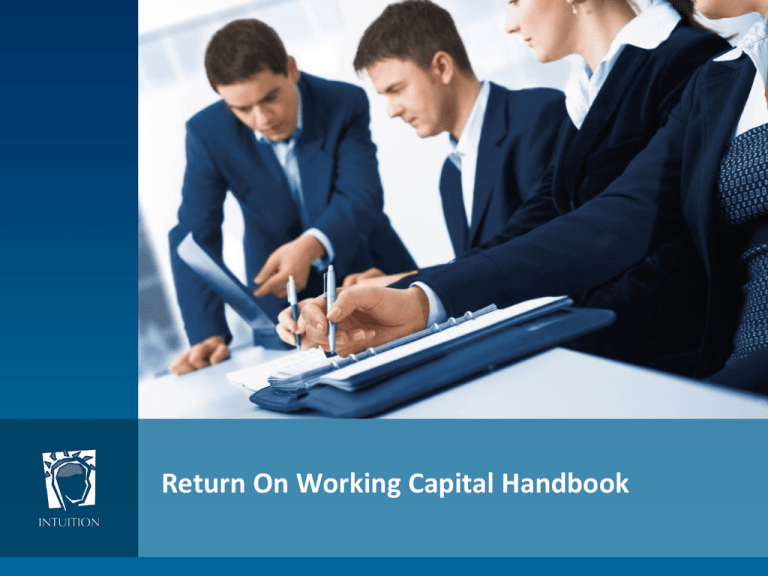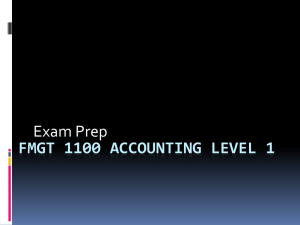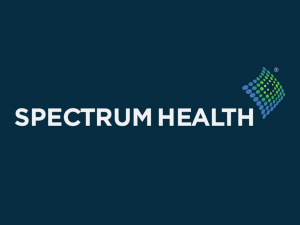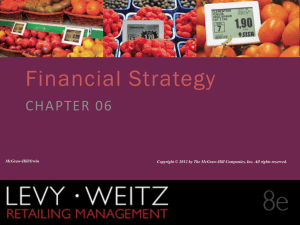
Return On Working Capital Handbook
Structure of Handbook
• This handbook has been created to help users to construct a ROWC model
• It starts by explaining the importance of ROWC as a business measure
together with the quick calculation
• We then move on to the ROWC model with its 5 drivers
- Gross margin
- Cost structure
- Inventory days
- Days sales outstanding
- Days purchases outstanding
• There are explanations for each driver on the subsequent pages
2
© 2011 Intuition Consulting Pte Ltd. All rights reserved.
Return on working capital (“ROWC”)
Return on
Working Capital
Operating Profit
Working Capital
ROWC is one of the most important measures for a business. It reflects for
any business the:
• Total business opportunity of the market focus
• Strength of the value proposition
• Quality of asset and resource management
• Ability to negotiate with customers for value not price
• Ability to be rewarded for value by suppliers
• Barriers to entry in a given industry
• Competitive advantages
• Threat of being substituted
3
© 2011 Intuition Consulting Pte Ltd. All rights reserved.
ROWC model
Together with an example
Return on
Working Capital
7.14%
Operating
Margin
ROWC is a multiplication of Operating Margin (determined by the
profit model) and Working Capital Turn (determined by the
working capital model)
x
1%
7.14
5%
4
Cost Structure
-
4%
© 2011 Intuition Consulting Pte Ltd. All rights reserved.
Working Capital Days
measures the time it takes
between paying a supplier and
receiving cash from the
customer
Working Capital
Days
Operating Margin is the difference
between Gross margin and Cost
structure
Gross Margin
Working Capital Turn measures
how many times per year
working capital turns
Working Capital
Turn
51.1
Inventory Days
36.5
+
+
Days Sales
Outstanding
43.8
-
Days Purchases
Outstanding
29.2
Financial Statements to ROWC
Two financial statements, the income statement and the balance sheet can be
simplified into the following formats
Example Income Statement
Net sales and other income
Period
Currency
$
100
Cost of sales
Performance Rebates
$
$
(97)
2
Gross profit/ margin
$
5
Selling, General and Administrative costs
Operating profit/ margin
(4)
$
1
Example Balance Sheet
Period
Currency
Investment in non working capital
Stock/ Inventory
$
Receivables
$
Creditors/ Accounts Payable
$
Investment in working capital
Net Assets
Shareholders funds/ equity
Borrowings
Invested Capital
From these financial statements, the ROWC model can be constructed.
5
© 2011 Intuition Consulting Pte Ltd. All rights reserved.
$11
10
12
(8)
$14
$25
20
5
$25
Gross Margin
Example Income Statement
Net sales and other income
Period
Currency
$
100
Cost of sales
Performance Rebates
$
$
(97)
2
Gross profit/ margin
$
5
%
100%
-97%
2%
© 2011 Intuition Consulting Pte Ltd. All rights reserved.
Gross Profit
= 5%
Sales
5%
Key definitions
1. Net sales represent invoices to resellers net of
any returns
2. Cost of sales includes the direct costs of the
product and/ or service that has been invoiced
to resellers. For a distributor this is typically the
vendor costs of the product net of any rebates
that are directly passed through to the reseller
3. Performance rebates are those incentives paid
by vendors that should be protected by the
distributor and form part of their profitability
6
Gross Margin
Measure
Gross margin measures the value
delivered to the customer that the
customer is willing to pay for
Cost structure
Example Income Statement
Net sales and other income
Period
Currency
$
100
Cost of sales
Performance Rebates
$
$
(97)
2
Gross profit/ margin
$
5
5%
(4)
-4%
Selling, General and Administrative costs
%
100%
Cost Structure
-97%
2%
SG & A Costs
Key definitions
1. Sales, General and Administrative (“SG&A”) costs
include the following costs of a distributor:
• Sales
• Marketing
• Logistics
• Occupancy, including warehousing
• Technology
• Corporate, finance and administration
2. SG&A does not include interest, tax and
extraordinary items costs
3. SG&A does not include those costs that have
been included in cost of sales
7
© 2011 Intuition Consulting Pte Ltd. All rights reserved.
= 4%
Sales
Measure
Cost structure measures the
productivity of the various
processes in the distributor, the key
process being sales
Operating Margin
Example Income Statement
Operating
Margin
Net sales and other income
Period
Currency
$
100
Cost of sales
Performance Rebates
$
$
(97)
2
Gross profit/ margin
$
5
5%
(4)
-4%
1
1%
Selling, General and Administrative costs
Operating profit/ margin
$
Key definitions
The difference between gross margin and cost
structure
Measure
The return on sales or the difference between
value and productivity
8
© 2011 Intuition Consulting Pte Ltd. All rights reserved.
%
100%
1%
-97%
2%
Gross Margin
5%
Cost Structure
-
4%
Inventory days
Example Balance Sheet
Period
Currency
Investment in non working capital
$11
Days
Stock/ Inventory
$
Receivables
$
Creditors/ Accounts Payable
$
Investment in working capital
Net Assets
Shareholders funds/ equity
Borrowings
Invested Capital
Key definitions
Included in inventory are:
• Goods held for resale
• Goods In Transit
• Work in Progress
• Spares
9
© 2011 Intuition Consulting Pte Ltd. All rights reserved.
10
12
(8)
$14
36.50
43.80
-29.20
Inventory
Days
Inventory x 365
= 36.5 days
Sales
51.10
$25
20
5
$25
Measure
Number of days of working capital
tied up in inventory
Days Sales Outstanding (“DSO”)
Example Balance Sheet
Period
Currency
Investment in non working capital
$11
Days
Stock/ Inventory
$
Receivables
$
Creditors/ Accounts Payable
$
Investment in working capital
Net Assets
Shareholders funds/ equity
Borrowings
Invested Capital
Key definitions
The time it takes between the date of
the invoice to customer and receiving
the cash
10
© 2011 Intuition Consulting Pte Ltd. All rights reserved.
10
12
(8)
$14
36.50
DSO
43.80
Receivables x 365
-29.20
Sales
= 43.8 days
51.10
$25
20
5
$25
Measure
The number of days credit provided
to customers usually dictated by
Terms and Conditions
Days Purchases Outstanding (“DPO”)
Example Balance Sheet
Period
Currency
Investment in non working capital
$11
Days
Stock/ Inventory
$
Receivables
$
Creditors/ Accounts Payable
$
Investment in working capital
Net Assets
Shareholders funds/ equity
Borrowings
Invested Capital
10
12
(8)
$14
© 2011 Intuition Consulting Pte Ltd. All rights reserved.
DPO
43.80
Payables x 365
-29.20
Sales
= 29.2 days
51.10
$25
20
5
$25
Key definitions
• The time it takes between the date of
the invoice from the supplier and
paying the invoice
• Netted off Accounts Payable can be
the amounts owed by the supplier to
the business (rebates etc)
11
36.50
Measure
The number of days credit provided
by suppliers usually dictated by
Terms and Conditions
Working Capital Turns and Days
Working
Capital Turns
7.14
Working
Capital Days
51.1
Inventory
Days
36.5
+
DSO
43.8
Key definitions
• Working Capital Turn measures how
many times per year working capital
turns
• Working Capital Days measures the
time it takes between paying a
supplier and receiving cash from the
customer
12
© 2011 Intuition Consulting Pte Ltd. All rights reserved.
-
DPO
29.2
Measure
• The faster you turn working
capital the better from both a
cost and ROWC aspect
• The lower the working capital
days the better as long as you do
not compromise the value
proposition
Conclusion
ROWC – The Business Model
Return on
Working Capital
• Every company is different
• Easy visual to understand the model
• Can be benchmarked
• Best practices can improve performance
7.14%
Operating
Margin
Working Capital
Turn
x
1%
7.14
Working Capital
Days
51.1
Gross Margin
5%
13
-
Cost Structure
Inventory Days
4%
36.5
© 2011 Intuition Consulting Pte Ltd. All rights reserved.
+
Days Sales
Outstanding
43.8
-
Days Purchases
Outstanding
29.2










